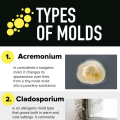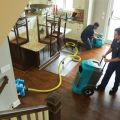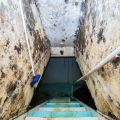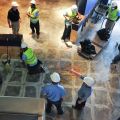Molds are usually not a problem indoors unless mold spores land on a wet or damp spot and begin growing. Molds have the potential to cause health problems. Molds produce allergens and irritants. Allergens are substances that can cause allergic reactions. Inhaling or touching mold or mold spores may cause allergic reactions in sensitive individuals. Allergic responses include:
Signs That Your Home Needs Mold Inspection

Time will not cooperate with you after a water disaster. The longer you’re going to wait for the restoration to be done, the greater the chances your items become unrecoverable. It would also pave the way to acquiring risky growths of mold damage if you don’t act immediately and decisively by contacting ServiceMaster of Savannah.
After a water-related catastrophe, it is a good idea to have an emergency plan ready anytime before any catastrophe strikes. ServiceMaster of Savannah, a document restoration and water damage restoration in Savannah that can install air dry distributions on-site, a great idea for businesses with a lot of important hard- copy information.
However, it does mean that you must take immediate action. Many people actually live in a home with mold and never realize it is there. They ignore the warning signs until the problem reaches a point where the mold is taking over and affecting their health.
CAN MOLD MAKE YOU SICK?
- Hay fever-type symptoms (sneezing, runny nose, red eyes, and skin rash)
- Breathing Difficulties
- Skin irritation
- Other Allergic reactions
- Aggravation of asthma symptoms
Allergic reactions to mold are common. They can be immediate or delayed. Also, mold exposure can irritate the eyes, skin, nose, throat, and lungs of both mold-allergic and non-allergic people. Symptoms other than the allergic and irritant types are not commonly reported as a result of inhaling mold. You can also learn more here about the other effects of mold on our health.
HERE ARE THE MOST TYPICAL MOLDS THAT CAN BE FOUND IN ANY PROPERTY:
Acremonium - Is considered a toxigenic mold. It changes its appearance over time, from a tiny moist mold into a powdery substance.
Cladosporium - is an allergenic mold type that grows both in warm and cold settings. It commonly thrives in carpets, fabrics, and upholsteries, as well as inside cupboards and under floorboards.
Trichoderma - Is an allergenic mold that is white-colored with green patches. Its common habitat are wet areas such as carpets, wallpaper, and other damp fabric.
Aspergillus - Commonly sprouting around certain properties, the Aspergillus can cause severe reactions. Some of its adverse effects are respiratory infections, allergic reactions, and inflamed lungs. In case this mold type won’t be eradicated in any area at home, it could surely impose inconvenience.
Aureobasidium - Typically found on the wooden furniture, surfaces, painted walls, and wallpaper, it can be noticed that it is in black and pink color. According to certain studies, this type of mold is the worst because of its extreme effects on homeowners by intensive allergic reactions.
Alternaria - Usually found in the sink, shower, and dark areas at home, the Alternaria mold threatens homeowners with an asthma attack and allergic reactions. It could be commonly found both indoors and outdoors around the property.
WHY IS AIR QUALITY TESTING NECESSARY?
You’ve almost certainly heard us say at some point that the air inside your home can be up to five times more polluted than the air outside your home. High indoor relative humidity in damp buildings also can increase the number of house dust mites present indoors and these mites are an important source of indoor allergens.
Many building materials also emit chemicals into indoor air and increased dampness in these building materials may also lead to increases in emission rates of gaseous non-microbial chemicals, for example, formaldehyde.
This is why air quality testing is necessary. This will measure your indoor air quality and check for any humidity in the area. This will ensure that mold growth will not be present in your home, avoiding any mold-related health problems.
MOLD REMEDIATION PROCESS
- Locating the mold and the water sources that feed mold
- Assessing the damage caused by the mold
- Isolating & containing the mold by using techniques like physical barriers & negative air pressure to prevent it from spreading
- Capturing, filtering & scrubbing microscopic mold spores from the air
- Removing mold with antimicrobial & antifungal treatments
- Disposing of mold-infested porous materials
- Cleaning, sanitizing & deodorizing belongings as needed
- Repairing & reconstructing damaged areas to restore your home
WHY CALL A MOLD REMEDIATION COMPANY?
There are a lot of mold remediation companies in Savannah. But, who’s the best? At ServiceMaster of Savannah, our Savannah mold remediation experts have the tools, training, and expertise to locate and remove all mold spores from your home or business. Our mold remediation specialists will repair and remove any type of mold damage including black mold. After inspection and determining that mold is present, our mold remediation experts will thoroughly clean and treat all affected surfaces.
If you do suspect that you may have a mold problem, you’ll need to put on your investigator hat and get to work right away. For professional emergency mold damage restoration services in Savannah, Georgia, and its surrounding areas, contact ServiceMaster of Savannah at 912-234-0270.









